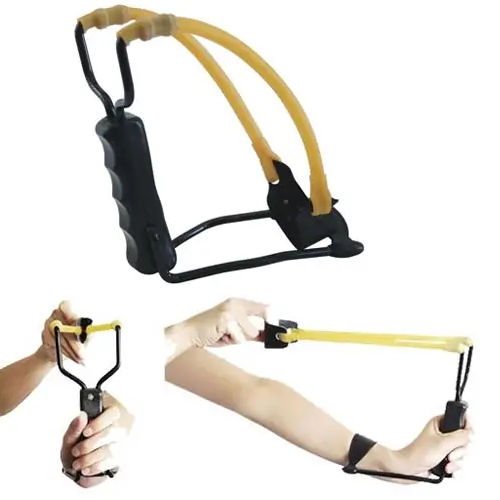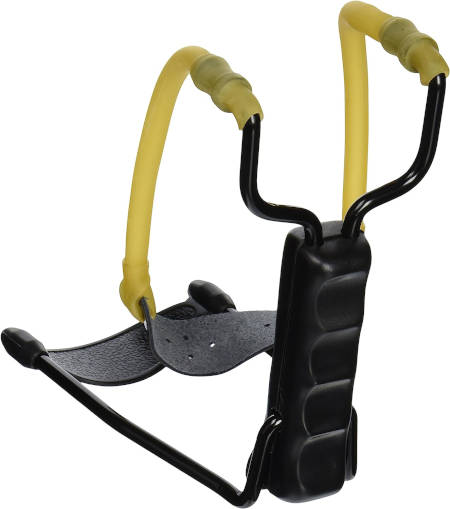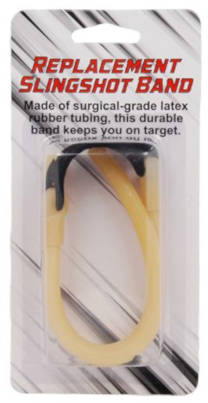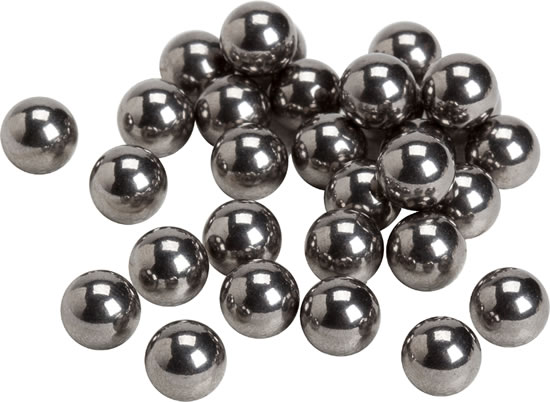Physics Behind Slingshots

Unleash your inner underdog with the simple yet fascinating tool that once brought down a giant. Yes, we're delving into the captivating world of slingshots. You remember David and Goliath? That monumental biblical battle where a common shepherd boy triumphed over an intimidating warrior? David's weapon of choice was not a colossal sword or an extravagant spear; it was a humble slingshot. And its power? Derived from the provocative laws of physics.
Don’t be fooled by its simple appearance—a slingshot is not merely child's play. It is in fact a profound representation of how physics materializes right in our hands. A single pull and release can make you a master only if you apprehend what forces come into play, how energy transforms, and why trajectory counts. Let's journey together to unlock the intriguing physics behind slingshots and learn how to shoot like a pro. After all, there may be hidden Goliaths in your life waiting to be tumbled!
Slingshots use stored elastic energy to launch a projectile at high speed. The key principle of this is maximizing draw length and draw force, which determines the stored energy, and minimizing friction to avoid energy loss. Understanding these principles is important when designing or using a slingshot for maximum effectiveness.
Physics Behind Slingshot Mechanics
Slingshots have intrigued humans for centuries, and it is not just because they can serve as cost-effective hunting tools or toys. It is the physics behind slingshot mechanics that makes them so fascinating. Understanding how a slingshot works and the basic principles involved can help you improve your aim, range, and shot accuracy. At its core, slingshot shooting involves the conversion of mechanical energy into kinetic energy to propel a projectile towards its intended target. But how exactly does this happen? Let's dive into the physics of slingshots.
To get a better understanding of this concept, let's use an analogy: think of a slingshot like a small-scale bow and arrow. Just like pulling back on a bowstring stores elastic potential energy that is used later to launch an arrow, pulling back on a rubber band in a slingshot stores elastic potential energy to launch a projectile. The amount of stored energy depends on various factors such as the distance pulled back and the force applied.
With that analogy in mind, let's take a closer look at the two main components of slingshot mechanics: elastic energy and projectile speed.
- According to research related to the Physics Department of Southeast University in China, a slingshot can accelerate a projectile to speeds of up to 130 km/h.
- Slingshots practice Hooke's law with force varying linearly with extension, hence making them a good application of elastic potential energy, which is converted to kinetic energy during release.
- A study published in the European Journal of Physics concluded that alterations in slingshot designs could improve power and accuracy by as much as 50%, using science-backed insights on draw force and draw length.
Elastic Energy and Projectile Speed
Slingshot physics revolves around the use of elastic bands specially designed for storing and releasing high levels of kinetic energy. By twisting the bands before stretching them, we can store even more potential energy in them than if stretched flat out. This stored elastic energy then transfers to the projectile when released, adding to its speed.
Think of it like winding up a spring—when compressed; it stores potential kinetic energy that can be later converted to motion. Similarly, with slingshots, once the elastic bands are stretched by pulling back on them with your fingers and holding them there until you release them, you have created stored potential energy. When released, this energy drives the projectile toward its target at high speeds.
Folding Slingshot
It's essential to note that the projectile's speed depends on three factors: the amount of force applied by the shooter, the distance (draw length) pulled back on the slingshot and the mass of the ammunition itself.
Think of it like a roller-coaster ride: the higher you go up the first hill (increased draw length), and more force is pushing it forward (increased draw strength), the faster it travels down to reach maximum speed (kinetic energy). Similarly, with slingshots, pulling back on its elastic bands farther (longer draw length) can increase acceleration and hence increase projectile velocity. The more massive the projectile being launched, the more resistance there is initially, which means slower initial velocity compared to a lighter projectile.
However, some may argue that shooting lighter projectiles could increase speed as they will encounter less resistance when moving through air. While lightweight projectiles do travel faster than heavier projectiles when shot from a slingshot under similar conditions, their lack of momentum causes them to lose speed disproportionate to their weight upon hitting objects. This makes heavier projectiles generally preferable for hunting or impact-based activity like knocking down targets.
Now that we have learned about elastic energy and projectile speed in slingshots, let's take a closer look at maximizing these two basic physics conditions.
Maximizing Draw Length and Force
Slingshot shooting requires the slingshot operator to pull back the projectile with a certain amount of force before releasing it. The degree of this force applied to the rubber band is referred to as draw length and force. To achieve maximum speed and distance, one must understand how to maximize these factors.
To maximize draw length, the operator needs to position their hand on the frame's farther backside as they begin to pull the projectile back. A longer draw means that more energy can be transferred from the shooter’s hand to the rubber band. This increase in tension results in a greater velocity when released.
When maximizing draw force, two factors become relevant: the slingshot design and the muscle strength needed for a perfect shot. Using a slingshot that has comfortable ergonomics can make it easier for the shooter to apply pressure onto the rubber band. While using a homemade or less comfortable model may require a more substantial exertion of muscular effort.
Newton's 3rd law principles are crucial to making sense of this dynamic. Newton's 3rd law of motion states, "for every action, there is an equal and opposite reaction." This law helps us understand why it is necessary to have maximum draw force when firing from a slingshot. Essentially, pulling back on the rubber band will cause an increase in tension that will create an equal yet opposite reaction on whatever is being fired out of it; meaning that if you are firing something small like a marble, then your rubber band needs to be pulled much harder than it would need to be for a bigger projectile like a golf ball.
To understand Newton's third law better, picture holding a bag full of tennis balls and chucking them at a wall as hard as you can. Imagine throwing one ball at a time versus throwing three balls at once with your dominant hand’s same force. You might find that throwing a single ball with all your force is much easier than throwing three at once. What's happening is that by adding more tennis balls, the overall weight increases, making it more challenging to throw with maximum force. The same principle applies to slingshot shooting, where one must consider both draw length and force simultaneously.
The stored energy in a rubber band used in a slingshot can be calculated using the formula dmax * Fmax = M*V^2 (where dmax equals the maximum draw length, Fmax equals the maximum force of the rubber band when stretched to dmax, M equals projectile mass, and V equals velocity). The equation shows that if the operator were to increase either draw distance or pull strength without changing anything else, the amount of kinetic energy imparted would increase.
As we move from maximizing draw length and force, another crucial factor that comes into play while looking for improved shooting accuracy and power is material selection.
Impact of Material Selection on Slingshot Physics
The materials used for a slingshot play an essential role in determining its performance. Different materials have different properties that affect how they store and release elastic energy when stretched.
Choosing appropriate rubber band quality and material is vital because they are responsible for storing and releasing elastic energy that powers the projectile after being released from the slingshot. Elastic bands come in varying thicknesses denoted by millimeters or gauges. One positive effect of a thicker rubber band is that it will result in better slip-resistance; because it allows for a stronger grip during power distribution when pulling back on an object before launch.
Slingshot Extra Band and Pouch
It’s also important to note that different types of rubber have varying characteristics like density resistance to tension fatigue, as well as stress-strain values that drive spurt speeds, hence affecting shot power and accuracy. For example, latex is a material commonly used in high-performance slingshots for hunting, but natural rubber is better suited for long-range target shooting.
In addition to rubbers and elastic bands, the slingshot frame's material may also affect its performance. Metal frames provide better stability than plastic ones by holding the projectile more securely, while wooden frames can add an aesthetic aspect to the slingshot’s look.
A prime example of how a material choice can significantly impact the performance of a slingshot would be with two identical-looking rubber bands made from different materials. Suppose one were made from thicker rubber than the other, and both stretched the same distance before being released at their maximum strength. In that case, you will notice quite a significant difference in the amount of energy (force) each would generate as they propel objects forward - simply because of their material properties.
While some might argue that investing in high-quality materials such as stable metal frames or top-quality latex rubber can improve accuracy and power, others view it as less critical. They believe that any material can function optimally with enough skill honing and use over time. Because despite these materials playing fundamental roles in these physics mechanisms producing the best possible, user experience is often contingent on how well a shooter can handle their tool.
With a solid understanding of maximizing draw length and force, and of choosing appropriate materials for your slingshot, we’ll now proceed to advanced slingshot designs and their distinct physics attributes.
Effect of Rubber Band Quality and Material
Rubber bands are the primary source of elastic energy in slingshots, so selecting the right type and quality of rubber band is crucial for achieving maximum speed and impact energy. Not all rubber bands are created equal, and depending on their quality and material composition, they can have varying levels of stretchiness, durability, and performance.
For instance, cheap rubber bands made from natural or synthetic rubber may have a lower tensile strength, which means they can break easily when stretched beyond their limits. On the other hand, premium rubber bands made from high-quality latex or medical-grade silicone can have higher tensile strengths and elasticity levels, which allow them to store more energy and release it more efficiently upon firing.
Additionally, the thickness and width of the rubber band can also affect its performance. Thicker bands can provide more resistance and force when being pulled back but at the cost of increased draw weight. Wider bands, on the other hand, can offer better stability and shooting accuracy but may compromise speed and power.
That said, understanding the properties of different rubber band materials is only half the battle. The user's skill plays an equally important role in maximizing the slingshot's potential. In the following section, we'll cover some techniques that can help you master slingshot accuracy and power.
Mastering Slingshot Accuracy and Power
In addition to selecting the right rubber band material for your slingshot, mastering your shooting technique is equally essential to achieve consistent accuracy and power. Here are some tips to help you improve your slingshot skills:
First off, just like archery or firearm hunting, proper posture and stance are critical to achieving accurate shots with a slingshot.
-
Stand with your feet shoulder-width apart and perpendicular to the target. This provides a stable base and helps with balance.
-
Position your non-dominant hand (left hand for right-handed shooters and vice versa) slightly forward, holding the slingshot handle firmly.
-
Place the projectile (such as a stone or a ball) in the pouch of the slingshot, holding it with your dominant hand.
-
Extend your dominant arm forward, keeping it slightly bent at the elbow.
-
Keep your non-dominant arm extended to the side, acting as a support and stabilizer.
-
Align your dominant eye with the target, using the slingshot and your extended arm as a guide.
-
Focus on the target and aim by adjusting the angle and elevation of the slingshot.
-
Pull back the pouch and stretch the rubber bands by exerting force with your dominant hand, keeping the slingshot steady and balanced.
-
Maintain a consistent grip and aim, and release the pouch smoothly, allowing the projectile to be propelled towards the target.
Think of yourself as a turret on a tank - stable yet aiming dynamically.
Secondly, practice consistently to develop good muscle memory and refine your shooting form. Start by shooting from close distances before gradually increasing the range as you become more comfortable and confident. Experiment with different angles and heights until you find what works best for you.
Thirdly, there are two schools of thought when it comes to grip placement on a slingshot: fork-supported or pinch-grip. In the former, the shooter holds the slingshot firmly against the index finger and thumb, with the projectile resting in between the forked ends of the rubber band. In contrast, in a pinch-grip method, the shooter uses only their fingers to hold the projectile and pull back the rubber band. Both techniques have their pros and cons, so choose whichever feels more comfortable and natural for you.
Steel Shot used as projectiles.
Finally, pay attention to your breathing pattern when shooting. Optimally taking deep breaths before pulling back allows you to fine-tune your focus at will instead of being affected by involuntary spasms that can disturb your aim.
With these tips in mind, you'll be well on your way to becoming a slingshot pro. In our final section, we'll cover some advanced slingshot designs that can take your shooting game even further.
- To improve your slingshot skills, it's important to have the right rubber band material and master your shooting technique. Focus on proper posture and stance, practice consistently, experiment with grip placement, and pay attention to your breathing pattern when shooting. These tips can help you become a slingshot pro and achieve consistent accuracy and power.
Techniques for Improved Range and Aim
Slingshots can be deadly weapons when used precisely, but it takes a lot of practice to develop the accuracy and range needed to hit targets reliably. Whether you're using a traditional wooden fork and rubber bands or a modern high-tech slingshot, there are several techniques you can employ to improve your aim and maximize your range.
One of the most important things you can do is find the right grip on your slingshot. Everyone's hands are different, so experiment with different positions and tensions until you find what is most comfortable for you. You'll want to be able to grip the slingshot firmly without causing unnecessary strain or tension in your muscles. Many experienced slingshot shooters prefer to hold their slingshots with their thumb and index finger wrapped around the forks, with the rubber bands resting between their fingers.
Proper stance is also essential. Stand with your feet shoulder-width apart, with your dominant foot slightly back from the other one. This will give you a stable base from which to shoot without compromising your balance or mobility.
Another effective technique for improving accuracy is to use both eyes when aiming. Closing one eye may feel more natural at first, but it greatly limits your field of vision and depth perception. Keeping both eyes open allows you to better judge distances and spot subtle movements of your target, leading to significantly improved accuracy.
Think of aiming like taking a photograph - try to compose the shot in your mind before actually taking it. Focus on lining up the fork and elastic band correctly, as well as making sure that there isn't any side-to-side wobble before shooting.
Now that we've gone over some basic techniques for improving accuracy, let's talk about how advanced slingshot designs take physics into account.
Advanced Slingshot Designs and Their Physics
Although traditional slingshots have been around for thousands of years, modern manufacturing techniques and materials have led to the creation of some truly remarkable designs. The physics behind slingshots can be quite complex, but sophisticated engineering can help maximize power and accuracy in ways that would have been impossible in the past.
One such design is the double-band slingshot, which takes advantage of multiple rubber bands to increase draw length and force. This dramatically increases the speed and energy of the projectile, resulting in greater accuracy over longer ranges. An added bonus is that double-band slingshots are typically easier to hold steady than single-band models.
Another advanced slingshot design is the compound slingshot, which uses a system of pulleys to reduce the amount of effort required by the shooter to draw back the elastic band. This allows for a longer draw length, which in turn results in greater force and speed when the projectile is released. Compound slingshots were originally developed for hunting purposes but are now widely used by enthusiasts who demand maximum performance from their equipment.
However, some argue that advanced designs take away from the traditional feel of slingshots, valuing simplicity over novelty. While this may be true for some, it's hard to argue with the advances in accuracy and power that can be achieved with high-tech slingshots. Ultimately, it comes down to personal preference and what works best for each individual shooter.
It's like choosing between an old-fashioned mechanical watch or a smartwatch - both tell time but offer different levels of complexity and functionality.
Whether you prefer traditional wooden fork models or high-tech compound versions, mastering aim and understanding advanced designs will improve your results in using slingshots.
Ready to try out your aim? Pick up your Slingshot.



